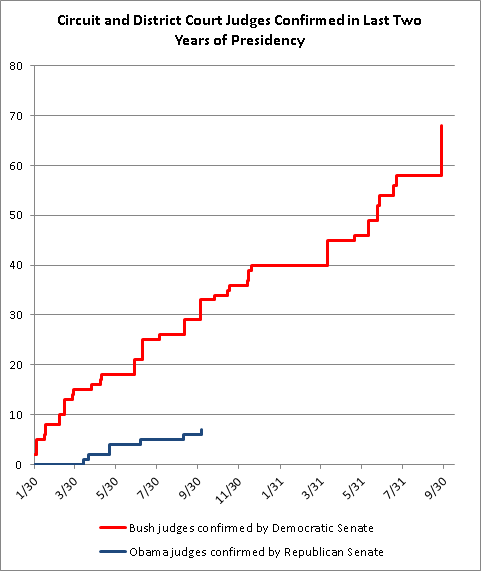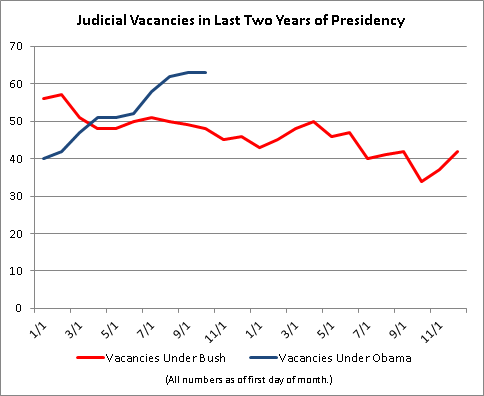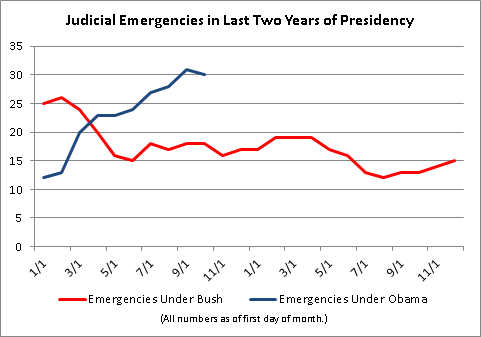To: Interested Parties
From: Paul Gordon, Senior Legislative Counsel, People For the American Way
Date: UPDATED October 5, 2015
Re: Reckless Obstruction: Blocking Nominees, Blocking Justice
Under the leadership of Mitch McConnell, the Republican-controlled Senate has surprised even cynical observers at the extent to which it has failed to fulfill its most basic duties. Few of its responsibilities are more important than confirming qualified federal judges: Courts are the infrastructure of justice, just as important to our constitutional rights as roads and bridges are to transportation.
Unfortunately, the Republican Senate is failing to carry out its basic obligation of confirming federal judges. They are weakening the entire third branch of the United States government and harming individuals and businesses across America. As we head into autumn, it is incumbent on Senate Republicans to process judicial nominees in a professional manner.
Failing to confirm judges is not at all the norm even when the Senate and the White House are held by different parties. A useful basis of comparison is George W. Bush’s final two years in office, when Democrats took over the Senate after the 2006 midterms. A week after those elections, Senator Patrick Leahy – who was about to become chairman of the Judiciary Committee – criticized Republicans for blocking votes on more than a dozen of Bush’s qualified nominees. Partisanship took a back seat to responsible governing.
So in 2007, Leahy and new Majority Leader Harry Reid worked together to make sure the Judiciary Committee and full Senate fulfilled its constitutional responsibilities. During those two years, the Senate vetted and confirmed 68 of Bush’s circuit and district court nominees. In fact, the Democratic Senate had already confirmed 33 of Bush’s judges by this same point in the year (October 5 of 2007). In stark contrast, the McConnell Senate has so far confirmed only seven Obama judges. No matter how you look at it, 33 ≠ 7.
The figure below shows the stark difference in the pace of confirmations under today’s Republican-controlled Senate as compared to the Democratic-controlled Senate of Bush’s last two years.
 |
Another way of contrasting how seriously Senate Democrats took their job in 2007-2008 versus the attitude of Republicans today is to track the number of vacancies. Judicial vacancies open regularly and predictably, since judges usually announce their intent to retire or go into semi-retirement up to a year in advance. Just to keep the number of vacancies at an even level requires that several new judges be confirmed each month.
At the beginning of 2007, there were 56 circuit and district court vacancies. Throughout the next two years, the number of vacancies generally remained at 50 or fewer, getting as low as 34 in the early fall of 2008. Because an unusually high number of vacancies opened up after Election Day, that number climbed back to 55 by Inauguration Day, but even with that increase, the number of vacancies ended up at about what it had been two years earlier.
Today, in stark contrast, the number of vacancies is climbing steadily, from 40 at the beginning of the year to 63 today, a nearly 60% increase.
 |
We see the same thing with judicial emergencies, a formal designation assigned by the Administrative Office of U.S. Courts for vacancies where the caseload per judge is so high that it endangers access to justice. Judicial emergencies have skyrocketed from 12 at the beginning of the year to 31 today. As the chart below shows, Democrats in the Senate during Bush’s last two years did not allow the number of judicial emergencies to increase in a similar fashion, and in fact the number generally remained steady or decreased during most of those two years.
 |
Majority Leader McConnell could start turning this situation around simply by scheduling votes. As the Senate prepares to leave town for its October recess, one circuit and eight district court nominees have been fully vetted and approved by the Judiciary Committee and are ready for a confirmation vote. Six of these have been languishing on the Senate floor since June or July. Six of the nominees would fill judicial emergencies. All were approved by the Judiciary Committee unanimously. Yet McConnell has made sure that none of these gets a timely confirmation vote. (Also denied floor votes are five nominees for the Court of Federal Claims and one for the Court of International Trade, all approved without opposition by the Judiciary Committee last year in the previous Congress and then again in February in the new one.)
Those being blocked include L. Felipe Restrepo of Pennsylvania, President Obama’s nominee for the Third Circuit Court of Appeals. He was nominated in November with the support of his two home state senators, Democrat Bob Casey and Republican Pat Toomey. He could and should have been confirmed long ago. Unfortunately, Judiciary Committee Chairman Chuck Grassley waited a full seven months after Restrepo’s nomination before even holding a hearing, even though he would fill a judicial emergency. (The chairman’s suggestion that the committee needed all that time to go through his background investigation was simply not believable, especially since Restrepo had just recently undergone an investigation when the Senate had confirmed him to a district court judgeship in 2013.) Adding insult to injury, Senator Toomey is apparently collaborating with his party leadership’s plans to delay that vote for as long as possible.
Also waiting too long are three district court nominees from New York: Ann Donnelly, LaShann DeArcy Hall, and Lawrence Vilardo, all of whom were approved unanimously by the Judiciary Committee in early June. At the end of July, after putting up with eight weeks of delay, New York Senator Chuck Schumer asked for unanimous consent for the Senate to hold a confirmation vote for them. However, Grassley refused, thereby preventing a vote. Importantly, Grassley did not claim that senators needed more time to vet the nominees. Instead, he said the Senate should not vote on the three New York nominees because the Senate was planning to vote in September on a nominee who had been waiting longer, and because the Senate had confirmed many of Obama’s judicial nominees in 2009-2014, including several during the lame-duck session last December. Of course, that is of no help to the individuals and businesses whose access to justice is curtailed by the lack of judges in New York.
For a chairman of the Judiciary Committee, it was a revealing moment, one that contrasted the current partisanship to the more responsible approach to running the Senate we saw in Bush’s last two years. Even when Republicans agree with Democrats that particular nominees are highly qualified to fill critically important positions in our nation’s judiciary, the GOP regards scheduling a vote as a major concession to the Democrats. The current Republican majority simply does not take governing seriously.